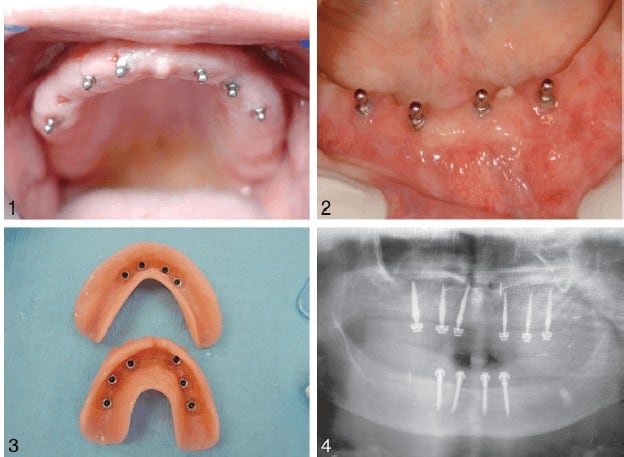The use of dental implants to replace natural teeth has become commonplace in contemporary restorative and surgical dental practices throughout the world. Authentication of their efficacy has been well documented in the dental literature. There have been many advances in surgical techniques and implant design features, and the use of implants in edentulous sites can be successful with predictable functional and esthetic outcomes.
Many studies suggest that mini dental implants can be used to retain removable complete and partial dentures in selected patients.
What are mini implants?
Mini dental implants are implants with diameters ranging from 1.8 to 3.3 mm and lengths ranging from 10 to 15 mm. Standard-measurement implants range from about 3.4 to 5.8 mm
Advantages of Mini implants:
- Easy to place and restore with appropriate preoperative data collection, such as osseous ridge contour and gingival quantity.
- Can be placed without raising flap
- Mini dental implants can be used to support fixed partial or complete dentures.
- Mini implants may be immediately loaded in the appropriate osseous situations and provide an alternative treatment if osseous conditions preclude a standard sized implant approach.
- Mini implants may be appropriate for clinical situations like an inadequate interdental space, reduced interocclusal space, convergent adjacent tooth roots, close proximity of adjacent tooth roots or narrow atrophic osseous contour.
- Mini implants are consistent with the trend towards minimally invasive dentistry.
- Small diameter or mini implants may provide solutions in patients where there is severe osseous atrophy or systemic conditions that may contraindicate protracted standard sized implant treatment.
REMOVABLE PROSTHETICS
Here, mini implants can stabilise removable prosthesis in both maxillary and mandibular region
Indication:
- Bone type Misch type I or II
- Atrophic bone
- Where immediate loading is required for primary stability of removal denture
- Where overdenture is needed
The minimum number of mini implants required for appropriate retention of complete removable dentures may be 6 in the maxilla and 4 in the mandible. The parallelism of mini implants for overdentures generally should not exceed 20 degrees to avoid non seating of the denture and conversion of axially directed loads to off-axial loads by the angled position of the implant. To ensure close parallelism for mini implant placement a surgical guide may be needed.

FIXED PROSTHETICS
Fixed prosthetics requires much greater off-axial forces, which may induce micro movement and result in the implant failing to integrate or a delayed loss of integration. Immediate loading is not indicated in fixed prosthesis. Clinical caution should be taken in these cases.
Indication:
- Bone should be Misch type I or II,
- An implant protective occlusal scheme should be used
- An occlusal scheme that distributes occlusal loads evenly is indicated
While a minimum of 6 implants may be needed to retain a maxillary removable complete denture, 10 to 12 implants may be needed to support splinted fixed complete maxillary prostheses. Occlusal and masticatory forces are distributed over multiple splinted implants, thus reducing the relative load on any single implant by increasing the surface area loaded against the supporting bone.
Two mini implants may be used for certain mandibular tooth-bound molar sites to accept a splinted crown restoration. Generally, these sites have shortened site lengths where a standard diameter implant may not fit with adequate tooth-to-implant spacing. Two mini implants can resist axial forces.
Single mini implants may support single crown restorations. Sites with short interdental space (less than 5 mm), such as maxillary lateral and mandibular incisors, and sites where tooth movement has imposed on the site length or the local anatomy is minute may accept a single mini implant. Anterior sites may be more appropriate because of lower occlusal forces. Surgical guides may be required for single or multiple mini-implant placements for fixed prosthetics. These guides can be constructed directly on a working cast by a laboratory technician.
When mini implants are splinted in fixed partial or complete dentures, the adjacent implants are anchored to each other, dissipating force and minimizing the potential for implant micro movement. However, cement loosening in one abutment may cause the fixed bridge to rotate slightly on the cemented abutment and lose osseointegration. An astute clinician may choose to definitively cement only mini-implant–supported prostheses to prevent this complication.
The most retentive metal-to-metal cements are the resins and resin-modified glass ionomers. Care should be taken to confirm that the surface tension of the mixed cement does not prevent the cement from reaching the deepest part of the casting during the cementation procedure.
Natural teeth have periodontal ligaments so teeth can easily intrude under an occlusal load to as much as 200 micrometre.Implants do not intrude under an occlusal load. During mastication, the implant-supported prosthesis may be the only contact and may thus withstand the full force of occlusion. This confirms that the implant-supported prosthesis will not bear the full force of the jaws during grinding.
LABORATORY CONSIDERATIONS FOR MINI IMPLANT FIXED PROSTHETICS
The coronas of mini implants are small. To construct fixed prostheses, the laboratory should use a polyurethane die material that is strong and durable for a working cast. To ensure a passive fit for the fixed prosthesis, an additional layer of die separator may be required. The lab technician can be trained to fabricate a wax pattern with a large lingual support and metal circumferential margin to prevent distortion of the pattern during lifting and spruing. The casting and porcelain application is then done as usual.
References:
- Shatkin TE, Shatkin S, Oppenheimer AJ, et al. A simplified approach to implant dentistry with mini dental implants. Alpha Omegan. 2003;96:7–15.
- Shatkin TE, Shatkin S, Oppenheimer. Mini dental implants for the general dentist. Compend Contin Educ Dent. 2003;24(S1):26–34.




















Hi,Arkaprava Saha
Thanks for this post.
This blog is covering all dental Mini implants Doubts.
Regards,
Pathak Dental Clinic, Pune
Thanks for this article. The article is beneficial and covering all dental implants Doubts.